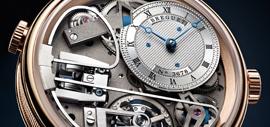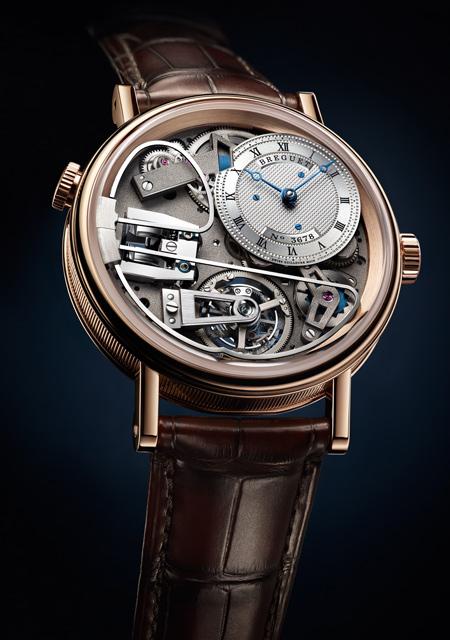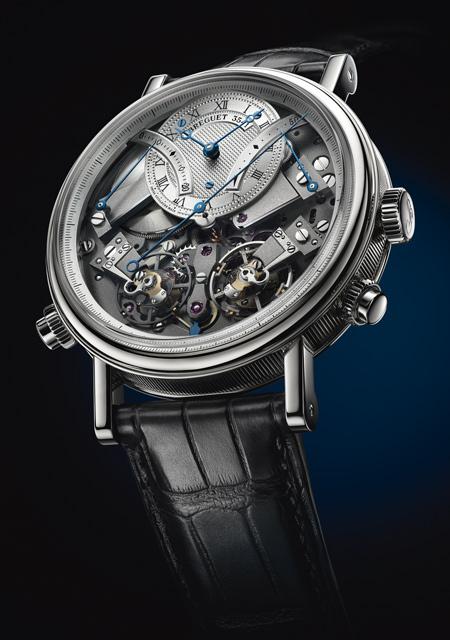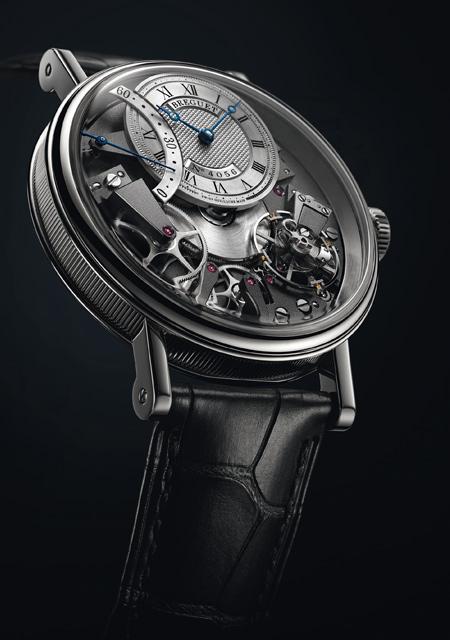Breguet Baselworld 2015: 10th anniversary of the watch Tradition
Since its beginnings in 1775, the Manufacture Breguet has earned the distinction of applying flawless style and technique to the creation of exceptional timepieces. Not content with reproducing the achievements of his predecessors, Abraham-Louis Breguet constantly sought to extend the limits of watchmaking, making an indelible imprint on history with such inventions as the pare-chute shock protection, the raised terminal curve (overcoil) of the balance-spring that takes his name, and of course the tourbillon. Beyond technical research, the company is also distinguished by its pursuit of elegance. Marrying beauty with mechanics, far from being contradictory, makes up a whole dedicated to the pursuit of one single purpose: to produce outstanding creations. Society in Abraham-Louis Breguet’s time recognised this, and with success came prestige. Among his clients were Queen Marie-Antoinette, Napoleon Bonaparte and Caroline Murat, queen of Naples. His reputation was such that he became a member of France’s board of longitude and chronometer-maker to the navy.
Over the years, Breguet has striven to perpetuate this creative vision and to pursue the quest for precision that was so important to its founder. Under the leadership of its President and CEO Marc A. Hayek, the company has broken free of horological taboos such as magnetism, by exploring new possibilities and unusual materials. This approach has enabled it to introduce a number of innovations designed to improve the regularity of its mechanisms and to shift horological paradigms. The balance-spring and escapement in silicon, magnetic pivots and research into acoustics and sound propagation were developed in tribute to Breguet’s pioneering spirit by using past experiences to push the existing boundaries.
If technical developments are closely bound up with Breguet’s history, so are its decorative principles. The company’s signature aesthetic codes and the outstanding level of finish done by hand according to age-old techniques permeate all its collections. Breguet is one of the few watch manufacturers that does all its engine-turned engravings in the traditional way, and it has recently expanded its workshops to keep ancient craft skills alive and to unite its artistic crafts in one location. This respect for tradition, constantly reformulated, is expressed in every timepiece. Breguet’s distinguished past is thus frequently revived by its craftsmen and women, who constantly create new timepieces that pay tribute to the past in a contemporary way. Inspired by Breguet’s historical “subscription” watches, the Tradition collection launched in 2005 and back in the spotlight this year, is an admirable example of this approach.
BREGUET TRADITION AUTOMATIQUE SECONDE RÉTROGRADE 7097
In 2005, Breguet launched its iconic Tradition collection with the 7027 model, the first timepiece to showcase the mechanisms of the movement on top of the baseplate. Much imitated but never equalled, this collection has since filled out and this year welcomes an outstanding new model: the Tradition Automatique Seconde Rétrograde 7097. The new watch, like the rest of the collection, is inspired by the “subscription watches” and recalls the genius of Abraham-Louis Breguet who first produced these one-hand watches in 1796. They were fitted with a very simple movement and sold by subscription: a down payment of a quarter of the price on order and the balance on delivery. Abraham-Louis Breguet also used the movements of his “subscription” watches for his first tact watches.
BREGUET TRADITION CHRONOGRAPHE INDÉPENDANT 7077
The chronograph occupies a choice position in watchmaking as a complication in its own right. Measuring elapsed times provides immediate visualisation of the desired function, but making it work is an additional mechanical challenge, because starting a chronograph disturbs the main gear trains. To alleviate this problem, Breguet has fitted its new Tradition Chronographe Indépendant 7077 model with two independent trains. The first is the going train for the hours and minutes, regulated by a 3Hz balance and having a power reserve of 50 hours. For the chronograph, the second transmission has a 5Hz frequency to ensure more precise readings, in harmony with the one devoted to measuring the passing of time. Breguet’s research into high frequencies shows that a higher rate of oscillations improves the stability of rate, since any disturbance is corrected more quickly. The two trains are entirely disconnected and the movement remains unaffected when the chronograph is started.
BREGUET TRADITION RÉPÉTITION MINUTES TOURBILLON 7087
The minute-repeater stands alone, even among the more coveted horological complications. Indeed, the transmutation of the passage of time into a series of crystalline notes takes on a poetic aspect and requires a great deal of technical dexterity. In addition to the precision and the regular rate of the model, watchmakers have to consider the striking mechanism, the quality of the sound and the energy needed for it to function properly. Over the years, Breguet has introduced many chiming watches in which innovations improved the sound. This year the company’s technicians have taken an original approach with the Tradition 7087. If watchmaking were a tapestry and the watchmakers were its weavers, they would have had to undo each thread of the work in hand so as to create a new work made of the threads of more recent research with the addition of outstanding innovations. Thus, this timepiece is presented in a completely new light, both in terms of approach and result.
Breguet’s watchmakers and engineers made a clean sweep of the usual methods to design their exceptional timepiece around the sound it produces. Using simulations they first synthesised about a hundred thousand sounds, which they classified into categories according to psychoacoustic criteria. These sounds were listened to and evaluated to ption by modern harmonies and tuning. The construction of the timepiece was then undertaken to reproduce the selected sound mechanically. This unprecedented approach determined the choice of every aspect of the watch, the innovations inherent in the shape of the components and the materials used for decoration. The brand’s characteristic styling was therefore carefully planned so as not to interfere with the desired sound.



